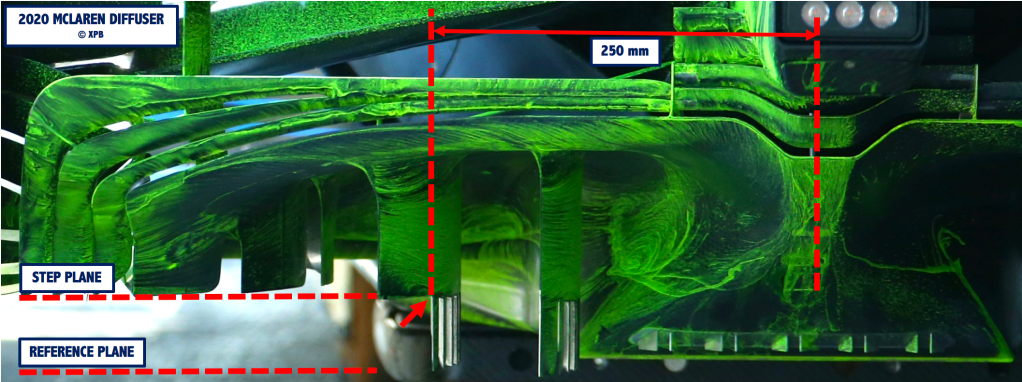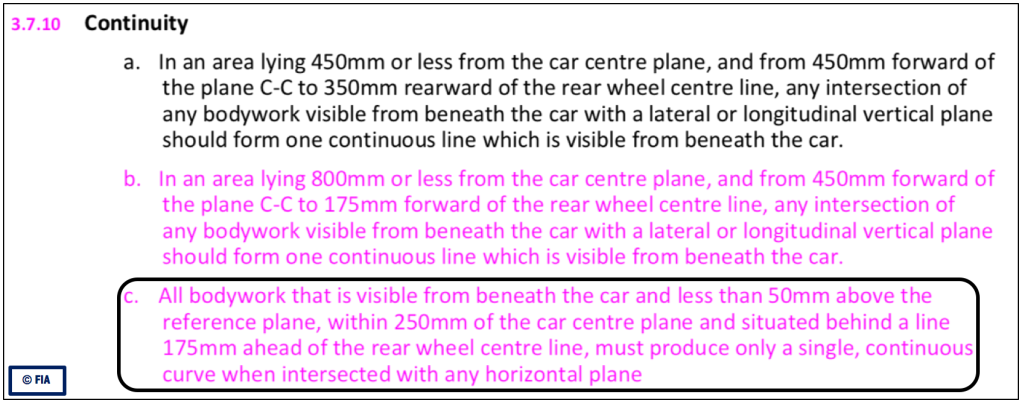McLaren’s new diffuser features a type of fence not seen in recent years in order to retain its height despite the floor regulations for 2021. It will not be a significant performance differentiator in anything like the way the double diffuser was, and it is likely that most, if not all teams have considered this concept in their development of their cars. This article will explain how the fence circumvents the intention of the rule changes, and what aerodynamic effect it may have.
Prior to this season, diffuser fences were allowed down to the reference plane, as long as they were positioned laterally within 250 mm of the centreline of the car. Many of the diffuser fences with ‘cut-outs’ (e.g. McLaren below from 2020) were due to them intersecting a vertical plane in this position. Outboard of this, the fences must lie no lower than the step plane, 50 mm above the reference plane.

However, for this year, the FIA introduced a new rule, Article 3.7.10c (see below), which did not explicitly outlaw taller fences further inboard, but attempted to do so using continuity. Taking a horizontal plane through bodywork in the region that the rule describes, less than 50 mm above the reference plane, will always intersect the middle of the diffuser ramp, which only starts expanding from the reference plane at the rear wheel centre line. Retaining one of the inboard, 2020-style fences less than 50 mm above the reference plane would not result in a single, continuous line when the horizontal plane intersects the necessary region.

The way in which McLaren has still managed to produce a tall fence is by connecting it to the diffuser ramp itself (see below), making it continuous when a horizontal plane slices through this region.

There will be multiple aerodynamic effects from the addition of this fence. Firstly, due to the greater height at its leading edge, it will pressurise the region outboard of it low down. This should help suppress the tyre squirt losses in the diffuser, reducing blockage further downstream and benefitting the whole device by increasing the mass flow. These fences will also produce a pair of vortices that provide upwash to the region between them – this has allowed McLaren to raise the height of the diffuser trailing edge compared to last year, while maintaining attachment, increasing overall expansion.
It should be noted that in the image of the 2020 McLaren diffuser above, which includes a flow viz, there was some significant flow separation where the diffuser centre expanded – this should also be alleviated with this new fence. Trimming the fence further rearward should help keep these vortices close to the diffuser underside, and hence maximise the support they give to the expanding ramp. However, control of these vortices is important, especially at low rear ride height when the diffuser loads up through ground effect. Due to the continuity rules, it will not be possible for the team to slot the fence tip until it is on/above the step plane to improve vortex losses and prevent breakdown in extreme conditions, whereas on the outboard fences this is not a constraint.
[…] McLaren MCL35M Diffuser […]
LikeLike